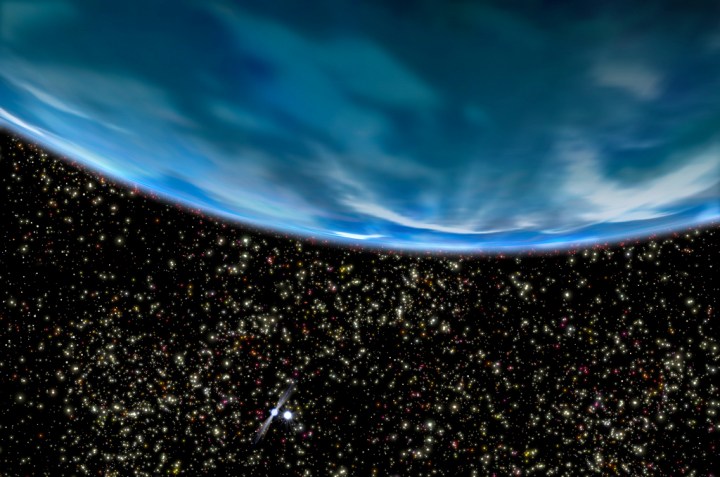Sci-Tech
Planet with ‘100% chance’ of alien life discovered, life on Earth mostly unmoved

From the time we began walking upright, we’ve been looking up at the heavens and wondering whether there’s life out there. On Wednesday 29 September, we received some convincing proof that there must be – on a planet called Gliese 581g in a relatively nearby solar system. Seems we don’t care as much as we pretended to. By KEVIN BLOOM.
It may be the easiest and most obvious question, probably even the laziest, but that doesn’t mean it’s not worth asking: why is the discovery of a habitable planet, which scientists say has a “100 percent chance” of sustaining life, not the number one news item on Google today? The facts are these: the planet’s name is Gliese 581g, it was found orbiting a nearby star in the “Goldilocks” region of space where the temperature is right for liquid water, it’s apparently the first truly Earth-like planet that the taxonomic genus known as Homo sapiens has discovered in its 200,000-year history. The top item on Google world news right now, since you’re asking, concerns the surprising information that terrorist cells remain active in Europe.
Granted, the planet is 20 light years from Earth, which is a little further than the radical cleric’s place on your cousin’s street in Rotterdam, but dude, there really is life out there! Practically confirmed! Not by the Kensington UFO club, by scientists who have been looking through the ground-based telescopes at the WM Keck Observatory in Hawaii for eleven years! Cool, huh? Worthy of the sort of front-page splashes that followed Neil Armstrong’s one giant leap, no?
No. The headlines, although there are quite a few of them, are careful and restrained; light on the exclamation points and heavy on the question marks. This in the Washington Post: “Astronomers find first habitable planet outside solar system”. This in the Los Angles Times: “Newly discovered planet may be most Earth-like ever, astronomer says”. This in the Daily Mail: “Is Gliese 581g the new Earth? Planet 20 light years away could support life”. Even The Sun, which may not have invented the exclamation point but certainly perfected it, could only manage: “New Earth is discovered”.
Time magazine, likewise under-appreciated for its temperance and self-control, went medium to large on the headline – “Found: An Earthlike Planet at Last” – but then dialed the relative excitement right down in the story’s opening paragraph: “The star known as Gliese 581 is utterly unremarkable in just about every way you can imagine. It’s a red dwarf, the most common type of star in the Milky Way, weighing in at about a third the mass of the Sun. At 20 light years or so away, it’s relatively nearby, but not close enough to set any records (it’s the 117th closest star to Earth, for what that’s worth). You can’t even see it without a telescope, so while it lies in direction of Libra, it isn’t one of the shining dots you’d connect to form the constellation. It’s no wonder that the star’s name lacks even a whiff of mystery or romance.”
To its credit, Time did go on to deliver what’s arguably been the most animated piece on the discovery since the announcement was made on Wednesday, 29 September. The journalist, Lynette Cook, pointed out that astronomers have identified more than 400 planets orbiting stars beyond the sun, and that Gliese 581, which has six planets, is now the largest known solar system outside our own. She also noted that Gliese 581g’s potentially historical significance lies in its mass – three to four times the size of Earth, which means it probably has a solid surface – and in its location in the “habitable zone” – which means it’s not too hot for water to boil nor too cold for it to freeze.
“As far as we know,” Cook continued, “that’s a minimum requirement for the presence of life. For thousands of years, philosophers and scientists have wondered whether other Earths existed out in the cosmos. And since the first, very un-Earthlike extrasolar planet was discovered in 1995, astronomers have been inching closer to answering that question. Now, they’ve evidently succeeded (although to be clear, there’s no way at this point to determine whether there actually is life on the new planet).”
The last sentence was the clincher, the four-word allusion to a discovery so monumental it could change Human consciousness forever, and the parenthetical observation that we may not want to get ahead of ourselves just yet. Still, there’s nothing ambivalent in the words of Professor Steven Vogt, the leader of the team of astronomers that found Gliese 581g. “Personally, given the ubiquity and propensity of life to flourish wherever it can, I would say, my own personal feeling is that the chances of life on this planet are 100 percent,” Vogt said at a press briefing. “I have almost no doubt about it.”
(Just to be clear, the top item on Google news in the few hours that it’s taken to write this article has changed – as of now, it’s the widespread anger at the European Union’s austerity measures). DM
Read more: Time magazine.
Illustration: G.Bacon for NASA.





 Become an Insider
Become an Insider